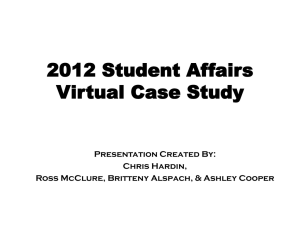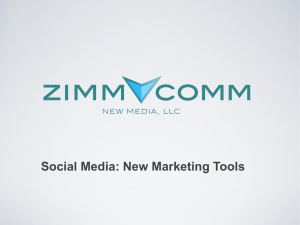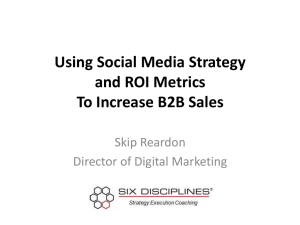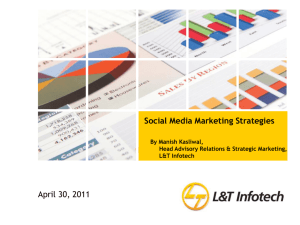University of Rhode Island (Montague team)
advertisement
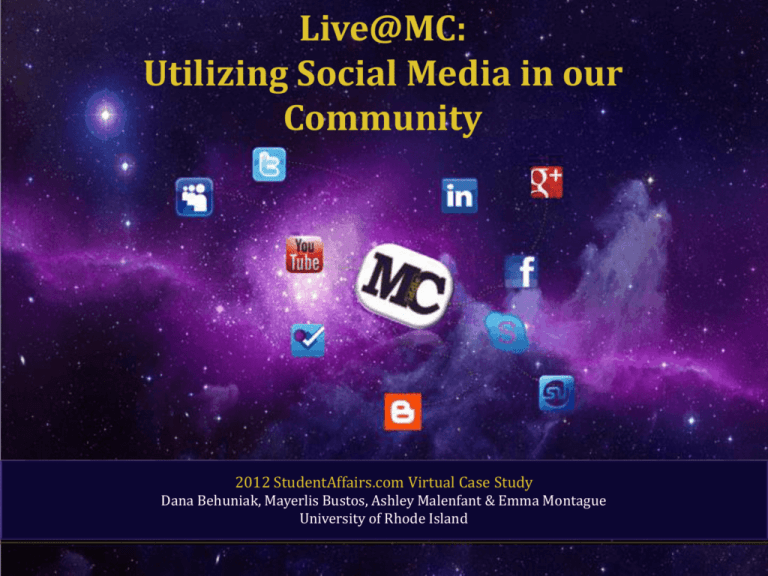
Live@MC: Utilizing Social Media in our Community Live@MC: Utilizing Social Media in our Community 2012 2012 StudentAffairs.com StudentAffairs.com Virtual Virtual Case Case Study Study Dana Behuniak, Mayerlis Bustos, Ashley Malenfant & Emma Montague Dana Behuniak, Mayerlis Bustos, Ashley Malenfant & Emma Montague University of Rhode Island University of Rhode Island Today’s Agenda o o o o o o o o Defining Social Media Effectively Utilizing Technology Drawbacks of Social Media Benefits of Social Media Benchmarking Social Media Guidelines Live@MC Future Needs Social Media Is… A collection of internet websites, services, and practices that support: o o o o Collaboration Community Building Participation Sharing The technology allows us to engage and motivate our students to be active learners. (Junco & Chickering, 2010) Effectively Utilizing Facebook What is it? A social networking site where users create personal profiles, add other users as friends, and join various fan pages related to their interests. Users have conversations through Facebook comments, polls, using the ‘Like’ button, and private messaging. Why are we paying attention? • 483 million people use Facebook daily (Facebook, n.d.) • 85-99% of college students use Facebook (Junco, 2011) How are we utilizing it? Many MC departments have fan pages to share updates with their “fans”, including our very own President Hooley, the Admissions Office, and Brown Library! Instructors have developed pages for their courses to continue discussions with their students outside of class and continuing to build that community. Effectively Utilizing Twitter What is it? Twitter is a microblogging and social networking site where users tweet 140 character long messages to their followers and follow other users who can range from President Obama to their roommate. Why are we paying attention? • Twitter has over 100 million active users (Twitter, September 8, 2011) • Twitter averages 140 million tweets per day (Twitter, March 14, 2011) How are we utilizing it? In First Year Seminar instructors have used Twitter for • Continuing class discussions • Informally answering student questions • Sending campus event reminders • Organizing group projects and study groups (Junco, Heibergert, & Loken, 2010) Business students are also utilizing Twitter to access a steady stream of information on current topics (Kupetz, 2010). Effectively Utilizing Google+ What is it? Google’s social networking site has its users create profiles and group their friends, families, and any other people into Circles to help people share information and connect with certain groups. Why are we paying attention? • Launched in June 2011 • Over 100 million Google+ users at the end of 2011 (Google Investor Relations, 2012) How are we utilizing it? While still a new technology, Google+ has started to be used to put classes into Circles and hold virtual office hours where professors meet with students using the Hangout feature. (Cabellon, 2011). Effectively Utilizing LinkedIn What is it? A professional networking site where users build a profile of their academic and career achievements. Users then add professional connections, join affiliated groups, and search for jobs. Why are we paying attention? • LinkedIn has over 150 million members in over 200 countries. • Membership includes executives from all 2011 Fortune 500 companies (LinkedIn Press Center, n.d.). How are we utilizing it? MC Career Services can use LinkedIn to assist students in the job search by helping them build their professional profile and apply for jobs through the system. Alumni Relations has also built a LinkedIn group to connect with MC alumni and provide those connections for our current students in their job and internship search. Effectively Utilizing Skype What is it? Skype is an application where users can connect with others by voice, video, and messaging over the internet. Skype is a free way to connect with people around the world in a face to face interaction. Why are we paying attention? • At peak times, there are 30 million people on Skype (Skype). • 12-18% of interviews are now being conducted over the internet (Winzenberg, 2011). How can we utilize it? Professors can now bring in guest lecturers from around the world by “Skyping” them into the classroom to speak with their students, this opens a great number of opportunities for MC. What better way for our students to learn a foreign language than through speaking with a native speaker? Skype makes that possible for more of our students! The Opportunities are Endless! o Blogs: Faculty, staff, and whole departments utilize blogging to spread information to its readers and encourage conversations. Many instructors have had success with developing a blog with course notes, and videos for their students (Kupetz, 2010). o Wikis: Course specific wikis allow students and instructors to develop a collaborative document for group projects which develops “participatory communities” (Kupetz, 2010, Hazari & North, 2009). o Second Life: Professors of online courses can create a virtual environment and their students acquire personal avatars so the class can interact and learn together, without ever meeting in person (Wang & Braman, 2009). o Youtube: Admissions videos, the Career Services professional dress fashion show, course lectures, and more are all available for current and perspective students to view and comment on via the MC YouTube channel. The Drawbacks of Social Media: MC recognizes the need for a Social Media Policy Incivility Professional Consequences • • • Students need to be educated on what to upload to public forums. There needs to be an awareness of the risks of posting unprofessional pictures of themselves and how they may be perceived by future employers if these pictures and/or comments were viewed. Employers will be looking for students to have a clean “net record” (Junco & Chickering, 2010). • • It is important to be educated on the potential harms of social media. Cyber bullying, harassment and even stalking can occur if students are not properly informed about how to correctly use public forums (Willard, 2007). “Communicating online can benefit both learning and psychosocial development but can also cause negative psychosocial and interpersonal effects” (Junco & Chickering, 2010). "In order to effectively introduce social media at a university there needs to be a set of policies or guidelines that outline the evolving legal and ethical issues that have emerged" (Coleman, Little, Lester, 2006). The Benefits of Social Media: Student Involvement Social o o Time on Facebook is positively related to time spent participating in cocurricular activities (Junco, 2012) High users of social networking sites spent more time in campus organizations than low users (Higher Education Research Institute, 2007) Academic o o When used in a seminar course, Twitter usage had a positive effect on student GPA (Junco et al., 2010) When used academically, social media meets the student in their comfort zone and develops unique dialogues and learning opportunities Benchmarking Guidelines Other Business Programs’ Social Media Guidelines: Bentley University, Massachusetts o o o “…do so with the understanding…” Accountability “…identity theft, stalking…” Recognizing Inappropriate Behaviors “…violating institutional policy…” Link to Established Student Policies (Bentley University, 2012) Bryant University, Rhode Island o o o “…are essential resources…” Highlighting the Benefits of Social Media “…managed responsibly…” Responsibility of the User “…effective, efficient, and responsible manner…” Urging Thoughtful Use (Bryant University, 2012) MC Social Media Guidelines As a member of the Middle College community, in accordance with the Student Handbook, and in an effort to uphold a positive presence on the Internet, I agree to the following guidelines: 1) Be Respectful I acknowledge the diverse use of social networking and the value of sharing information. I respect that others may have differing opinions or thoughts and will respect and pursue a civil discourse in my various online interactions. 2) Be Thoughtful I will consider my potential audience before posting harmful information via my social networking sites. I recognize that what I write online is widely available and will make an effort to portray myself in the most positive light online. 3) Be Accountable Despite the ambiguity of social media, I will hold myself responsible for the presence I create for myself online. I also understand that I will be held accountable for any inappropriate use of social media that is harmful to others. We encourage you to connect and engage through social media and applaud the innovative use of the medium. However, online behaviors that are inconsistent with the Student Handbook (i.e. cyber bullying, plagiarism of online works, interfering with teaching, learning, or other campus activities) are subject to appropriate sanctions if reported to the Middle College administration. Consequences may include conduct meetings through the Office of Judicial Affairs or dismissal from the Institution. Welcome to Live@MC 70% of prospective college students check social media websites once a day or more (The College Board and Art & Sciences Group, 2009); Live@MC would provide students with a centralized space to view Middle College information. Mission To produce a centralized media portal for MC students to be able to access their personalized media outlets, Middle College information, key information about the effective use of social media, and the MC Social Media Guidelines which students are expected to adhere to. New Visitors to Live@MC Once entering the Live@MC website, the Middle College Social Media Guidelines will pop up encouraging students to review our policies. Highlights: • Shows prospective student MC’s value in technology • Keeps the institution competitive with our benchmark institutions. • MC Twitter feed and Facebook Fan page will be displayed to keep students connected and to model appropriate usage of social media. • Anyone that goes to the website will be able to take advantage of the social media educational material. Current Students Features Students will need to sign in to the portal in order to access live plug in features. These features will need to be attached to their Middle College email. Middle College will not have access to the content of their social media information. Here students will have immediate access to their Middle College email inbox. This will make for efficient, official communication. MC ALERTS! Will display alerts that need to be sent to the MC community such as; weather alerts or campus safety notices. At the top of Live@MC students will be connected to the classroom with their Sakai (an online academic message board) updates from their instructors. The live feed plugins featured on Live @MC are Twitter, Facebook, YouTube, Linkedin, foursquare and Google+. The MC Social Media Base This is a campus wide event calendar that will keep students up to date on the latest academic, and campus life initiatives. In order for students to feel directly connected to what is going on in specific departments we have provided a list of MC endorsed social media venues. We encourage the President to work with Kim Brown, Director of Communications to create a presence on these social media sites to become familiar and connected to this initiative. Here students will find Social Media Feeds for the MC Facebook and Twitter pages. This MC campus wide feed will assist in increasing attendance and communication of campus activities . Effectively Using Social Media Live@MC provides videos at visitors fingertips. These videos are based on how to effectively search for jobs through social networking, safety measures and privacy settings along with the effectiveness of social media tools in the classroom. When students, faculty and staff click on “Making Social Media Work for You” they will find educational tools on how to best utilize social media networks. This page lists websites and videos on privacy, networking, how-tos and best practices of the most popular social media networks. Social Media in the Curriculum Classroom Spotlight is a part of Live@MC that appreciates and highlights the use of social media in the classroom. The purpose of this page is to: •Demonstrate MC’s competency and appreciation for technology •Highlight campus leaders that support Live@MC’s mission •Give community members ideas on how they can expand and approaches the learning goals in their classroom Future of Live@MC Roadblocks Recommendations Staffing • The website would undoubtedly develop over time and we would need to employ a technical team. • We would need to find tech-savvy individuals to ensure that the MC reputation was not being discredited by the community. Staffing • The website gives a fantastic opportunity for internships for business students. • Future plans would be to recruit a Social Media Graduate Assistant, a team of MC student bloggers, and a voluntary web-design team. • Student Organization Presidents would be provided with training in order to use the MC name in their advertisements. Accessibility • We cannot assume that everyone will have equal access to technology. • We cannot assume that everyone will have an interest in various social media outlets. Financial • The website is currently free and has already been designed by the student team however to add additional features there would be costs involved. Accessibility • The opening hours of the computer center are clearly advertised on the website. We would encourage students to log in to Live@MC while they are on campus. • Future plans would be to have visual screens/projectors of the MC website in different building across campuses, increasing awareness and accessibility to the website. • Tutorials on setting up social media portals, or a social media 101 component to curriculum at MC would enhance accessibility and community engagement in MC media. Financial • With 1500 students logging onto our site there would be potential for companies to pay for advertisements. • Businesses could target graduate students for future employment opportunities, benefiting both the business and our students. Presenting Live@MC We have provided you with a prototype of Live@MC. Feel free to explore, but please recognize that the plugins will not be live until the website is fully endorsed by Middle College. https://sites.google.com/site/livemiddl ecollege/ We welcome your feedback as we continue to develop Live@MC. References Bentley University. (2012). Computing and network policy. Retrieved from http://www.bentley.edu/offices/policies/computing-and-networkpolicy Bryant University. (2012). Information technology policy. Retrieved from http://web.bryant.edu/~commtech/it_policy.html Cabellon, E. (2011). Google Plus: The evolved online network. Retrieved from http://edcabellon.com/tech/googleplus/ Facebook. (n.d.). Fact sheet. Retrieved from http://newsroom.fb.com/content/default.aspx?NewsAreaId=22 Google Investor Relations. (2012). Google announces fourth quarter and fiscal year 2011 results. Retrieved from http://investor.google.com/ earnings/2011/Q4_google_earnings.html Grajak, S., & Arroway, P. (2012, January). The EDUCAUSE 2011 Core Data Service Report: Highlights and Insights into Higher Education Information Technology.EDUCause. Retrieved from http://net.educause.edu/ir/library/pdf/PUB8008.pdf Hazari, S. & North, A. (2009). Investigating pedagogical value of wiki technology. Journal of Information Systems Education, 20 (2), 187-198. Higher Education Research Institute. (2007) College Freshmen and Online Social Networking Sites. HERI Research Brief. Junco, R. (2011). The need for student social media policies. Educause Review. Retrieved from http://www.educause.edu/EDUCAUSE+Review/ EDUCAUSEReviewMagazineVolume46/TheNeedforStudentSocialMediaPo/222666 Junco, R. (2012). The relationship between frequency of Facebook use, participation in Facebook activities, and student engagement. Computers and Education, 58 (1), 162-171. Junco, R. & Chickering, A.W. (2010). Civil discourse in the age of social media. About Campus, 12-18. References Junco, R., Heibergert, G., & Loken, E. (2010). The effect of Twitter on college student engagement and grades. Journal of Computer Assisted Learning. Retrieved from http://blog.reyjunco.com/pdf JuncoHeibergerLokenTwitterEngagement Grades.pdf Kupetz, A.H. (2010). Social media and the business professor. BizEd, 9 (6), 44-48. LinkedIn Press Center (n.d.). About us. Retrieved from http://press.linkedin.com/about Nicholson, S. (2010). Inviting the world into the online classroom: Teaching a gaming in libraries course via youtube. Journal of Education for Library and Information Science, 51 (4), 233-240. Pew Internet. (2011). Demographics of internet users. Retrieved from http://www.pewinternet.org/Trend-Date/Whos-Online.aspx Skype. About Skype. Retrieved from http://about.skype.com/ The College Board and Art & Science Group (2009). Social Networking Sites and College-Bound Students . studentPOLL, 7(2). Retrieved from http:// professionals.collegeboard.com/data-reports-research/trends/studentpoll/social-networking Twitter. (2011, March 14). #numbers. Retrieved from http://blog.twitter.com/2011/03/numbers.html Twitter. (2011, September 8). One hundred million voices. Retrieved from http://blog.twitter.com/2011/09/onehundred-million-voices.html Wang, Y. & Braman, J. (2009). Extending the classroom through second life. Journal of Information Systems Education, 20 (2), 235-247. Willard, N. E. (2007). Cyberbullying and Cyberthreats. (pp. 1-313). USA: Research Press. Winzenburg, S. (2011). How skype is changing the interview process. Cronicle of Higher Education, 58(18). Retrieved from http://chronicle.com/article/How-Skype-Is-Changing-the/126529/ Any Questions? Director of Communications: Kimberly Brown Email: kbrownmiddlecollege@gmail.com Twitter: @KCKimBrown


